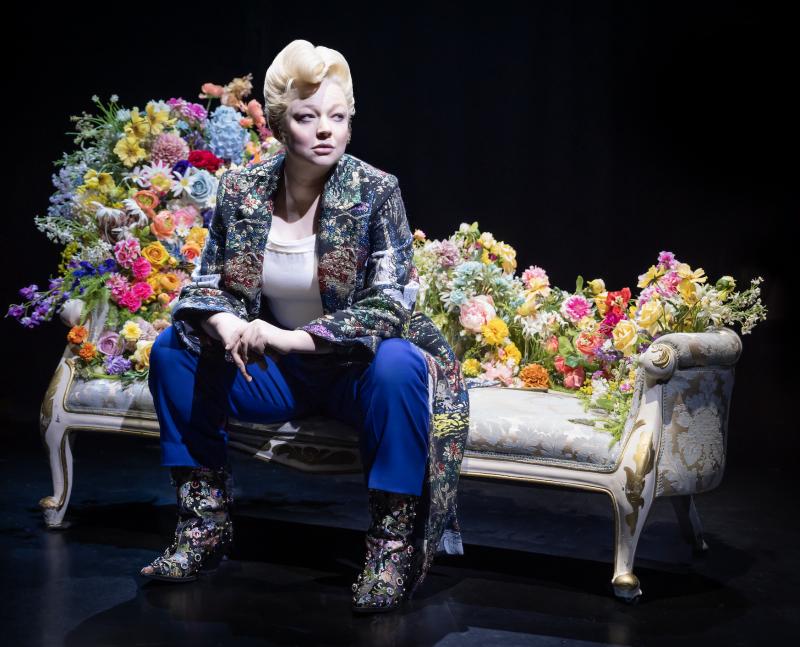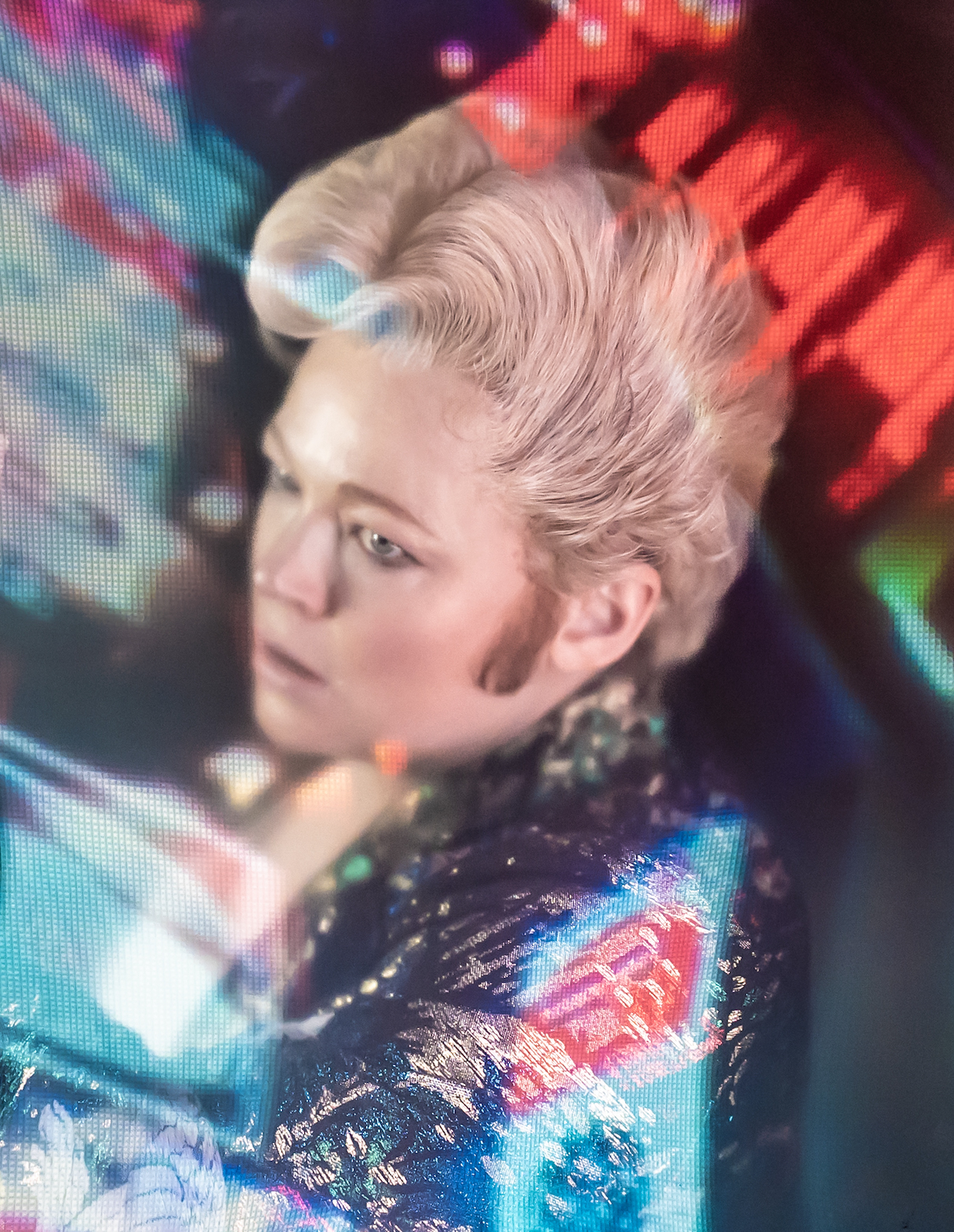The Picture of Dorian Gray, Theatre Royal Haymarket review - inventive rollercoaster of a revamp | reviews, news & interviews
The Picture of Dorian Gray, Theatre Royal Haymarket review - inventive rollercoaster of a revamp
The Picture of Dorian Gray, Theatre Royal Haymarket review - inventive rollercoaster of a revamp
Sarah Snook gives a virtuoso performance amid a dazzling display of tech wizardry

Oscar Wilde’s 1890 novella The Picture of Dorian Gray has given the world a trope built for flattery, along the lines of: “You look so young, you must have a portrait growing old in your attic”. But how many who use this line have read the text itself?
Kip Williams of the Sydney Theatre Company has and has retooled it inventively for a 21st century audience. What emerges is a dazzling display of virtuoso acting and technical wizardry. And it isn’t just gratuitous whizz-bangery. Williams is making a serious argument for the tale’s modernity by telling it via contemporary technology.
At the play’s heart is the solitary figure of Sarah Snook, now a familiar TV face as Shiv Roy in Succession. She arrives onstage au naturel in black shirt and blue trousers and begins to narrate the tale. But immediately it’s clear we are going to be mainly seeing her projected on a screen, not just moving around the stage. She is also accompanied by a large crew in black, who film her, help her change costumes, hand her lit cigarettes, shimmy along with her in a little chorus line at times.
Soon she has put on a white shirt and angelic blond curly wig, et voilà: Dorian Gray, a cherubic chappie amusingly flirting with the camera while his neurotic friend Basil paints him. Basil and another acquaintance, the smirking, sinister Lord Henry, have popped up on smaller screens descending from the flies, in prerecorded footage where Snook is dressed up as them — as she will be with a dozen other characters, each with a distinctive voice and facial gestures.
The production’s boggling choreography begins as Snook moves off to be filmed at the back of the stage, first at a miniature theatre, where Dorian has fallen in love with the actress playing Juliet, Sybil Vane. On the main screen we see his giant face behind its stage, marvelling at the puppet-actors. His fateful quest for “adventures”, triggered by a strange book Lord Henry has lent him about the primacy of beauty and the senses, has begun, and his wish to exchange his soul for permanent beauty has been fatally granted. His portrait starts to age unseen instead of him, for the next 18 years.
But the production is only just getting started in demonstrating its technical sophistication. Live-filming is already familiar to theatregoers from productions by Katie Mitchell and Ivo van Hove, who regularly create a live “film” of the play that is simultaneously projected above the stage. Williams and his designers, though, aren’t content with one screen and begin to multiply them, moving the action from screen to screen, with Snook often talking to herself as other characters in the various frames, with precision timing. By video sleight of hand, she even appears in the main screen as four different characters at once, or times her live dialogue to clash with a prerecorded one (with her back to the screen: extraordinary).
 The look of the piece is contemporary kitsch, with modern pop in the background and a full musical number, "Gorgeous" for Dorian. Soon he is kitted out with a modish blond quiff and sparkly outfits Elton John might covet, as he moves into a decadent demimonde where young men easily come to harm. His name becomes synonymous with bad behaviour at polite dinner parties (with Snook amusingly playing all present) and his company is shunned.
The look of the piece is contemporary kitsch, with modern pop in the background and a full musical number, "Gorgeous" for Dorian. Soon he is kitted out with a modish blond quiff and sparkly outfits Elton John might covet, as he moves into a decadent demimonde where young men easily come to harm. His name becomes synonymous with bad behaviour at polite dinner parties (with Snook amusingly playing all present) and his company is shunned.
This dressing up is great fun, giving Snook full rein to show her range, from ancient Aunt Agatha with a tower of grey hair and quivering voice, to assorted growly ugly men at dinner, Dorian’s pale former friend Alan Campbell, and both Sybil and her brutish brother, James, whom Dorian encounters in a disco come opium den — filmed in another set hidden under the stage — as his descent into hedonism and amorality reaches rock bottom.
Even this isn't the full extent of the technical tricks. Snook begins using a smartphone to film herself and supply the screen projections, which allows her to apply filters to her face. Dorian’s face is made slimmer and smoother, his eyes larger and bluer, his lashes monumental. Or she can make the filters turn Dorian ugly, sending a giant tongue flying out of his mouth while his face implodes. In the most impressive piece of stagecraft, she plays with her phone as she delivers her lines, revealing eventually the hideous version of her face she has been creating on its screen, a vision of what Dorian imagines his ageing portrait at home now looks like.
This isn’t merely stagecraft: Williams has made a direct connection between the solipsistic hedonism Wilde was probing and its correlative in contemporary life — the narcissism of selfie-taking, the self-obliteration of cosmetic surgery, the loneliness of social media addicts. Dorian’s embracing of sensual pleasures without consequences is more than a gothic chiller of a tale: it’s a parable about modern society, and not just Wilde’s late Victorian one. He could sense the shape of things to come, if not the finer details, of unbridled egos devoted to their own pleasure.
The whole crew takes a bow at the end alongside Snook, as they should: it’s a rollercoaster of a revamp, a brilliant achivement not least because the complex technical business doesn't obscure the drama of Dorian’s decline, only heightens it. This Dorian at his direst is still a poignant figure. And Snook doesn't put a foot wrong, even when, the night I attended, the filters on the first smartphone she used didn’t work and she coolly requested another. (Her only other ‘flub” was to stumble on the word “shiver”, audibly pulling herself up for it. If it wasn’t deliberate, it was certainly spooky, given her Succession name.) She is a hugely engaging stage presence, not merely a versatile trouper but a subtle, funny actress who conspiratorially draws you into the piece from the outset and only two hours later finallly lets you go.
- The Picture of Dorian Gray at Theatre Royal Haymarket until May 11
- More theatre reviews on theartsdesk
rating
Explore topics
Share this article
The future of Arts Journalism
You can stop theartsdesk.com closing!
We urgently need financing to survive. Our fundraising drive has thus far raised £49,000 but we need to reach £100,000 or we will be forced to close. Please contribute here: https://gofund.me/c3f6033d
And if you can forward this information to anyone who might assist, we’d be grateful.

Subscribe to theartsdesk.com
Thank you for continuing to read our work on theartsdesk.com. For unlimited access to every article in its entirety, including our archive of more than 15,000 pieces, we're asking for £5 per month or £40 per year. We feel it's a very good deal, and hope you do too.
To take a subscription now simply click here.
And if you're looking for that extra gift for a friend or family member, why not treat them to a theartsdesk.com gift subscription?
more Theatre
 Ragdoll, Jermyn Street Theatre review – compelling and emotionally truthful
Katherine Moar returns with a Patty Hearst-inspired follow up to her debut hit Farm Hall
Ragdoll, Jermyn Street Theatre review – compelling and emotionally truthful
Katherine Moar returns with a Patty Hearst-inspired follow up to her debut hit Farm Hall
 Troilus and Cressida, Globe Theatre review - a 'problem play' with added problems
Raucous and carnivalesque, but also ugly and incomprehensible
Troilus and Cressida, Globe Theatre review - a 'problem play' with added problems
Raucous and carnivalesque, but also ugly and incomprehensible
 Clarkston, Trafalgar Theatre review - two lads on a road to nowhere
Netflix star, Joe Locke, is the selling point of a production that needs one
Clarkston, Trafalgar Theatre review - two lads on a road to nowhere
Netflix star, Joe Locke, is the selling point of a production that needs one
 Ghost Stories, Peacock Theatre review - spirited staging but short on scares
Impressive spectacle saves an ageing show in an unsuitable venue
Ghost Stories, Peacock Theatre review - spirited staging but short on scares
Impressive spectacle saves an ageing show in an unsuitable venue
 Hamlet, National Theatre review - turning tragedy to comedy is no joke
Hiran Abeyeskera’s childlike prince falls flat in a mixed production
Hamlet, National Theatre review - turning tragedy to comedy is no joke
Hiran Abeyeskera’s childlike prince falls flat in a mixed production
 Rohtko, Barbican review - postmodern meditation on fake and authentic art is less than the sum of its parts
Łukasz Twarkowski's production dazzles without illuminating
Rohtko, Barbican review - postmodern meditation on fake and authentic art is less than the sum of its parts
Łukasz Twarkowski's production dazzles without illuminating
 Lee, Park Theatre review - Lee Krasner looks back on her life as an artist
Informative and interesting, the play's format limits its potential
Lee, Park Theatre review - Lee Krasner looks back on her life as an artist
Informative and interesting, the play's format limits its potential
 Measure for Measure, RSC, Stratford review - 'problem play' has no problem with relevance
Shakespeare, in this adaptation, is at his most perceptive
Measure for Measure, RSC, Stratford review - 'problem play' has no problem with relevance
Shakespeare, in this adaptation, is at his most perceptive
 The Importance of Being Earnest, Noël Coward Theatre review - dazzling and delightful queer fest
West End transfer of National Theatre hit stars Stephen Fry and Olly Alexander
The Importance of Being Earnest, Noël Coward Theatre review - dazzling and delightful queer fest
West End transfer of National Theatre hit stars Stephen Fry and Olly Alexander
 Get Down Tonight, Charing Cross Theatre review - glitz and hits from the 70s
If you love the songs of KC and the Sunshine Band, Please Do Go!
Get Down Tonight, Charing Cross Theatre review - glitz and hits from the 70s
If you love the songs of KC and the Sunshine Band, Please Do Go!
 Punch, Apollo Theatre review - powerful play about the strength of redemption
James Graham's play transfixes the audience at every stage
Punch, Apollo Theatre review - powerful play about the strength of redemption
James Graham's play transfixes the audience at every stage
 The Billionaire Inside Your Head, Hampstead Theatre review - a map of a man with OCD
Will Lord's promising debut burdens a fine cast with too much dialogue
The Billionaire Inside Your Head, Hampstead Theatre review - a map of a man with OCD
Will Lord's promising debut burdens a fine cast with too much dialogue

Add comment